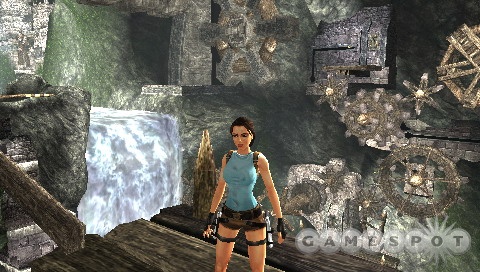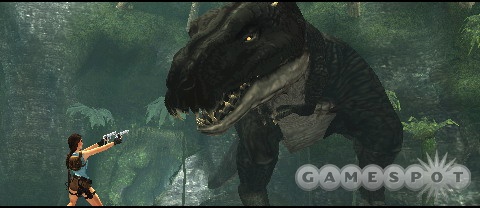When Tomb Raider first hit in 1996, it was nothing short of groundbreaking. While years of sequels that ranged from unremarkable to borderline offensive did a lot to tarnish the Tomb Raider name, developer Crystal Dynamics undid a lot of damage with last year's Tomb Raider: Legend. It focused on the strengths of the series--exotic locales, thoughtful puzzles, and incredible acrobatics--while modernizing the gameplay, as well as streamlining the whole experience. Crystal Dynamics continues its good work with Tomb Raider: Anniversary, which effectively goes back to the original Tomb Raider and rebuilds it from scratch. Now appearing on the PSP a few months after the PC and PS2 versions, Anniversary is still a solid action adventure game. However, some control compromises and inconsistent performance issues put a small dent in the experience.

Like the original, Tomb Raider: Anniversary follows the same basic tale of Lara's hunt for the Scion of Atlantis as she does battle with conniving businesswoman Jacqueline Natlas and her various henchmen. You'll explore ancient tombs and forgotten cities in Peru, Greece, or Egypt. You'll also perform plenty of death-defying acrobatics as you work your way through massive, ancient, and often deadly puzzles. The whole experience is highly evocative of the original, and there are certainly plenty of moments that seem specifically designed to create an odd sense of déjà vu. But nothing in Tomb Raider: Anniversary has been regurgitated verbatim: Everything is bigger and better. The environments are larger and more detailed, while existing puzzles have been elaborated upon, often to dizzying effect. The experience just feels bigger; there's so much new content that it honestly feels less like a remake and more like its own game.
A big part of that feeling comes from how much more talented Lara has become since the original Tomb Raider. Aside from a few, nominal differences, she's basically got the same abilities here as she had in Tomb Raider: Legend, which made her one of the most nimble action adventure heroes this side of the Prince of Persia. Her proficiency around ledges is incredible: She can shimmy across ledges, leap from one ledge to another, and scramble from one ledge to a higher ledge. She can swing from dangling ropes or horizontal bars, perform tumbling maneuvers to avoid projectiles, or climb up, leap from, and balance precariously atop vertical poles.
All of these acrobatics feel natural and not overly difficult to pull off, with the game allowing for just the right amount of margin of error. But as good as Lara is, she's got her limits, which is a big part of what makes the action feel dangerous. If your timing is off just a little bit when jumping for a ledge, Lara might only catch it with one hand, which will have you furiously mashing a button to help her recover. But if you miss the ledge completely, Lara's likely to expire or at least incur a serious amount of damage. These misses seem to come a little more often in the PSP version, which is due in part to some imprecision with the analog stick. Other minor sacrifices were made to the controls in bringing Anniversary to the PSP. The shoulder buttons are used to rotate the camera, and you can tap the triangle button to reset the camera position or hold it down to look freely around you with the analog stick. This works well enough most of the time, though during combat it can get a little sticky because you have to hold down both shoulder buttons to lock onto an enemy.
Lara will need to exercise each and every one of her abilities to their absolute limit in Tomb Raider: Anniversary, which features no shortage of ridiculous acrobatics. The game is essentially made up of a series of gigantic, unique set-piece puzzles. Sometimes the puzzles are traditional find-the-key, flip-the-switch-type affairs, but more often than not, the real puzzle is figuring out how to use Lara's ability to get from point A to point B. Additionally, the puzzles are often nested several layers deep. While your overall goal may be to find four keys to open a door, you'll first have to figure out how to get to the bottom of a gigantic, crumbling tower, after which you'll have to figure out how to access four different doors. Then you'll have to figure out how to actually open those doors. But of course, behind each of those doors lies a series of tricks and traps that you'll have to traverse before you'll get to the keys. Solving one of these overarching puzzles can be an involved process, with some of them taking well over an hour to complete.
The environments are your biggest adversaries most of the time in Anniversary, though through your exploration, you'll regularly run into some antagonistic fauna. These include rats, bats, wolves, bears, tigers, gorillas, raptors, and the occasional tyrannosaurus rex. Combat is limited to gunplay, which operates with a simple lock-on system. Lara can also tumble and flip through the air while keeping a bead on an enemy. New to Anniversary is the adrenaline dodge, which at specific moments allows Lara to dodge a charging enemy in slow motion. When time slows, a target will also slowly move toward the enemy, and if you fire the weapon right at the moment it locks on, it'll produce an instant kill, usually when the ferocious beast is just inches away from your face. It still feels like Tomb Raider combat, which has always been a minor part of the experience, but the adrenaline dodge is a nice little touch that adds a little more drama to the action. Tomb Raider: Anniversary also makes use of the same type of interactive cutscenes seen in Tomb Raider: Legend, where you'll have to quickly react to an onscreen button cue to keep Lara alive. It allows for some beautifully choreographed action sequences, but they're rarely very challenging.

What keeps Tomb Raider: Anniversary engaging throughout is the strength of the gameplay, as well as the quality of the presentation. Even though you're basically just going from one tomb to another, they feature enough individual detail to make them unique. The environments are also huge, using the occasional curvy hallway to mask load times. Aside from some minor gameplay contrivances, they feel pretty real. Lara looks great and moves with a natural grace that makes her incredible acrobatic feats look feasible instead of ridiculously superhuman, while the various wildlife you confront also moves convincingly. The quality of the design and the animation comes through intact on the PSP, but a few of the finer touches in the PC and PS2 versions are absent. These are specifically lighting and atmospheric effects. But of greater concern is Anniversary's inconsistent frame rate, which can obscure the game's lovely animation and also make the timing of jumps trickier than necessary. While the fidelity of the sound elements seem to have been reduced, the game's sound design still carries a lot of the weight in establishing atmosphere. You'll hear plenty of small ambient effects, such as animal calls and dripping water. Lara's grunts and yelps as she scales these incredible antiquities will also resonate differently depending on the size of the room. Music is generally used sparingly, but it always swells to a flourish at all the right moments.
Tomb Raider: Legend did a lot to make Lara Croft feel relevant again, and Tomb Raider: Anniversary is another step in the right direction. The acrobatic action is consistently exciting and challenging throughout. Thus, despite being a remake, the experience feels new and fresh. This is the best Tomb Raider game in years, and for the first time in a long time, that actually means something.